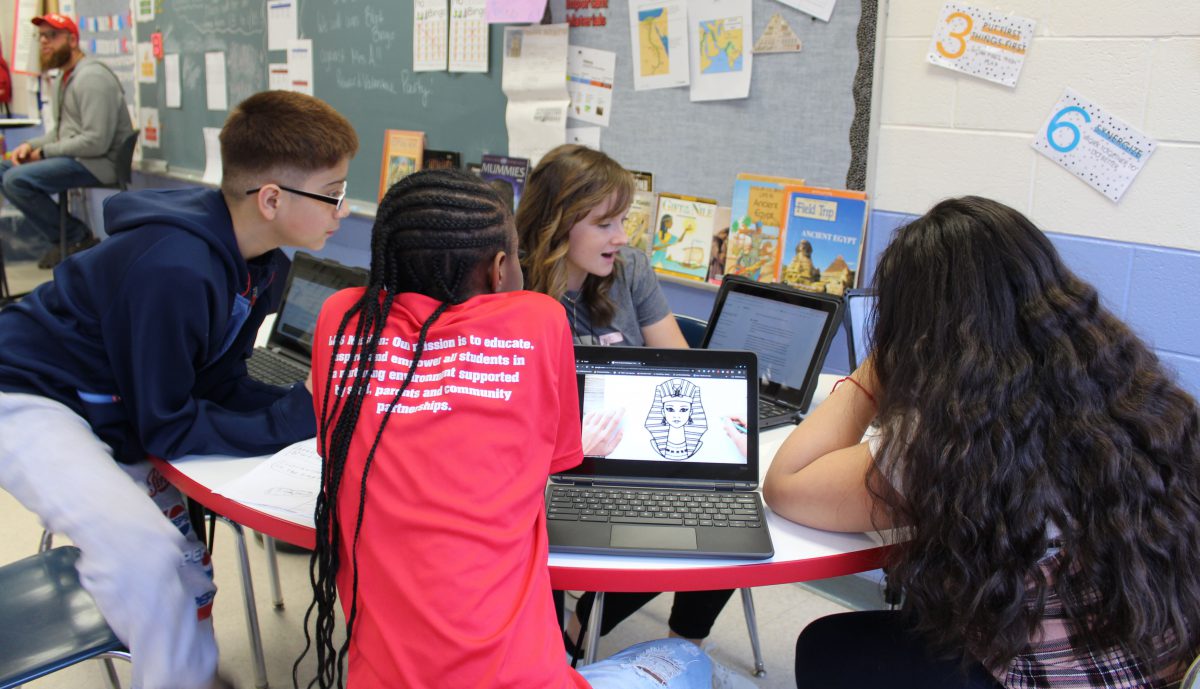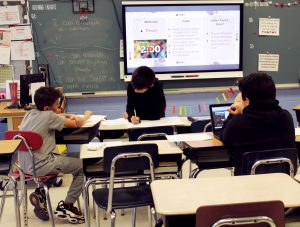New technology brings history to life

Liberty Central School District sixth-graders in Samantha Abplanalp’s social studies class recently had the opportunity to interview Egyptian pharaohs.
No, they didn’t travel in a time machine. They used ChatGPT.
“The idea of using AI can be scary, but I know that students will begin using it at some point in their academic career,” Abplanalp said. “I thought it would be better to teach students how to use AI appropriately now.”
In sixth grade, students learn about early humans and ancient civilizations, from Mesopotamia to ancient Egypt, then China, Greece and Rome. Abplanalp, who has been teaching at Liberty Middle School for three years, tries to make learning fun.
Using technology is one way Abplanalp works to keep her students actively participating in class. “I find that students are much more engaged in their learning when they are doing projects and collaborating with others,” she said.
Interviewing a pharaoh
In the pharaoh project, students are creating posters using facts garnered from credible sources on the internet. Students were provided a graphic organizer to plan the poster and write the facts that they found. They created interview questions that they would ask their pharaoh if given the opportunity. This is where ChatGPT came in. Students met in small groups with Abplanalp and asked their questions to ChatGPT.
To help students get accurate answers, Abplanalp asked ChatGPT to be the pharaoh and to reword responses for sixth graders.
“I think it was interesting because it acted like Cleopatra and told me that she purposely made a snake bite her because she was worried the Egyptians were going to kill her anyway,” student Zalaina Nash said.
After asking their questions, students had to decide whether ChatGPT answered their question and if it seemed accurate. They had to use an additional source to determine whether it was correct.
“I looked the same question up on a different website and got a different response, which showed me that ChatGPT might not always be accurate, just like we talked about in class,” student Madison LaMantia said.
“Before using ChatGPT in the classroom, I always discuss with students that it can provide inaccurate information, just like other sources that can be found online,” Abplanalp said.
AI in the classroom
Students were shocked by how fast ChatGPT responded to their questions, Abplanalp said. Many students were looking forward to the interviews, and they were really excited when fact checking and finding that ChatGPT generated an accurate response, she added.
“It was a fun assignment where students got to play around with technology while also learning that AI can have errors,” Abplanalp said.
Her students had used AI previously when studying the Indus River Valley. They asked questions, and Abplanalp typed them into ChatGPT. She read the responses aloud, and the class discussed how some of the questions couldn’t be answered since archaeologists themselves were unable to answer those questions.
The program actually inspired the pharaoh activity, Abplanalp said. “When I was thinking about how ChatGPT could be used in the classroom, I played around with it to see what ideas it could give me.”
She typed in “‘How can I use ChatGPT in the classroom?” and one of the ideas generated was having it pose as a historical figure.
 The program helped spark ideas for students as well.
The program helped spark ideas for students as well.
“I like how ChatGPT tried to figure out when Cleopatra’s birthday was, and I like how it gives you extra information. This helped in my research because it gave me more ideas of what I can put on my poster,” student Milana David-Colon said.
“I look forward to seeing how else AI can be used in the classroom,” Abplanalp said. “I know that AI is becoming a big part of the world around us and as technology continues to advance, there is no question that the use of AI will continue to grow.”
Beyond social studies
The class uses Putnam Northern Westchester BOCES curriculum, which is an integrated social studies and ELA curriculum. Abplanalp said her initial ideas come from the curriculum, and she tries to add in engaging activities.
Since the social studies curriculum integrates ELA, students spend a lot of time reading, writing and answering comprehension questions. “Sometimes students don’t even know if they are in ELA or social studies,” Abplanalp said.
The curriculum in different classes often align and work off of each other. In the spring, when students begin learning about ancient Greece in social studies, they begin reading “Percy Jackson and the Lightning Thief” by Rick Riordan in ELA. The novel discusses the Greek gods and goddesses.
“When students begin reading, the lines between social studies and ELA really blur and the kids seem to enjoy how the two blend together,“ she said.
And it is more than ELA lessons that cross over into social studies. The ChatGPT project showcases the importance of fact-checking and accuracy. Students also learn about the geography of the world, different cultures and how history impacts the world today. Students are able to see the similarities and differences between ancient civilizations and they can even compare them to our lives today.
Using aligned curriculum, explicit direct instruction and supportive teaching methods are all part of the district’s five-year strategic plan and its supporting Middle School Priority Document to improve academic outcomes.
“I often think back to when I was in social studies in elementary school. I can still remember many of the engaging activities that my teachers did in the classroom, from dressing like Greek gods and goddesses to building a replica of the Great Wall of China, I was given the opportunity to be creative while learning, and those are the lessons I will never forget,” Abplanalp said. “As a teacher, I want my students to not only retain what they learn, but to enjoy school and the learning process.”

